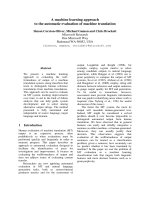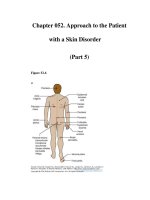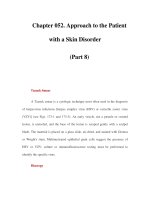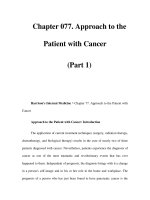Chapter 077. Approach to the Patient with Cancer (Part 1) potx
Bạn đang xem bản rút gọn của tài liệu. Xem và tải ngay bản đầy đủ của tài liệu tại đây (44.73 KB, 8 trang )
Chapter 077. Approach to the
Patient with Cancer
(Part 1)
Harrison's Internal Medicine > Chapter 77. Approach to the Patient with
Cancer
Approach to the Patient with Cancer: Introduction
The application of current treatment techniques (surgery, radiation therapy,
chemotherapy, and biological therapy) results in the cure of nearly two of three
patients diagnosed with cancer. Nevertheless, patients experience the diagnosis of
cancer as one of the most traumatic and revolutionary events that has ever
happened to them. Independent of prognosis, the diagnosis brings with it a change
in a person's self-image and in his or her role in the home and workplace. The
prognosis of a person who has just been found to have pancreatic cancer is the
same as the prognosis of the person with aortic stenosis who develops the first
symptoms of congestive heart failure (median survival, ~8 months). However, the
patient with heart disease may remain functional and maintain a self-image as a
fully intact person with just a malfunctioning part, a diseased organ ("a bum
ticker"). By contrast, the patient with pancreatic cancer has a completely altered
self-image and is viewed differently by family and anyone who knows the
diagnosis. He or she is being attacked and invaded by a disease that could be
anywhere in the body. Every ache or pain takes on desperate significance. Cancer
is an exception to the coordinated interaction among cells and organs. In general,
the cells of a multicellular organism are programmed for collaboration. Many
diseases occur because the specialized cells fail to perform their assigned task.
Cancer takes this malfunction one step further. Not only is there a failure of the
cancer cell to maintain its specialized function, but it also strikes out on its own;
the cancer cell competes to survive using natural mutability and natural selection
to seek advantage over normal cells in a recapitulation of evolution. One
consequence of the traitorous behavior of cancer cells is that the patient feels
betrayed by his or her body. The cancer patient feels that he or she, and not just a
body part, is diseased.
The Magnitude of the Problem
No nationwide cancer registry exists; therefore, the incidence of cancer is
estimated on the basis of the National Cancer Institute's Surveillance,
Epidemiology, and End Results (SEER) database, which tabulates cancer
incidence and death figures from nine sites, accounting for about 10% of the U.S.
population, and from population data from the U.S. Census Bureau. In 2007, 1.445
million new cases of invasive cancer (766,860 men, 678,060 women) were
diagnosed and 559,650 persons (289,550 men, 270,100 women) died from cancer.
The percent distribution of new cancer cases and cancer deaths by site for men and
women are shown in Table 77-1. Cancer incidence has been declining by about
2% each year since 1992.
Table 77-1 Distribution of Cancer Incidence and Deaths for 2007
Male Female
Sites %
Numb
er
Sites %
Numb
er
Cancer Incidence
Prostate 29
218,89
0
Breast 26
178,48
0
Lung 15
114,76
0
Lung 15
98,620
Colorect
al
10
79,130
Colorecta
l
11
74,630
Bladder 7 50,040
Endometr
ial
6 39,080
Lympho
ma
4 34,200
Lympho
ma
4 28,990
Melano
ma
4 33,910
Melanom
a
4 26,030
Kidney 4 31,590
Thyroid 4 25,480
Leukemi
a
3 24,800
Ovary 3 22,430
Oral
cavity
3 24,180
Kidney 3 19,600
Pancreas
2 18,830
Leukemia
3 19,440
All
others
18
136,53
0
All others
21
145,28
0
All sites 10
0
776,86
0
All sites 10
0
678,06
0
Cancer Deaths
Lung 31
89,510
Lung 26
70,880
Prostate 9 27,050
Breast 15
40,460
Colorect
al
9 26,000
Colorecta
l
10
26,180
Pancreas
6 16,840
Pancreas 6 16,530
Leukemi
a
4 12,320
Ovary 6 15,280
Liver 4 11,280
Leukemia
4 9470
Esophag
us
4 10,900
Lympho
ma
3 9060
Bladder 3 9630 Endometr
ial
3 7400
Lympho
ma
3 9600 CNS 2 5590
Kidney 3 8080 Liver 2 5500
All
others
24
68,340
All others
23
63,750
All sites 10
0
289,55
0
All sites 10
0
270,10
0
The most significant risk factor for cancer overall is age; two-thirds of all
cases were in those over age 65. Cancer incidence increases as the third, fourth, or
fifth power of age in different sites. For the interval between birth and age 39, 1 in
72 men and 1 in 51 women will develop cancer; for the interval between ages 40
and 59, 1 in 12 men and 1 in 11 women will develop cancer; and for the interval
between ages 60 and 79, 1 in 3 men and 1 in 5 women will develop cancer.
Overall, men have a 45% risk of developing cancer at some time during their
lives; women have a 37% lifetime risk.
Cancer is the second leading cause of death behind heart disease. Deaths
from heart disease have declined 45% in the United States since 1950 and
continue to decline. Cancer has overtaken heart disease as the number one cause of
death in persons under age 85 years (Fig. 77-1). After a 70-year period of
increases, cancer deaths began to decline in 1997 (Fig. 77-2). The five leading
causes of cancer deaths are shown for various populations in Table 77-2. Along
with the decrease in incidence has come an increase in survival for cancer patients.
The 5-year survival for white patients was 39% in 1960–1963 and 68% in 1996–
2002. Cancers are more often deadly in blacks; the 5-year survival was 57% for
the 1996–2002 interval. Incidence and mortality vary among racial and ethnic
groups (Table 77-3). The basis for these differences is unclear.
Figure 77-1









